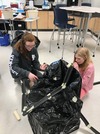
Unrestricted Use
CC BY
Lesson Length: 1-2 hoursGrade Level: 6-8Students learn about potential and kinetic energy as it relates to mountain roads. The activities are grounded in engineering design thinking as it relates to engineered roads and road repair. Also included is a challenge activity with renewable energy Snap Circuit simulations.This material is based upon work supported by the National Science Foundation under Grant No. 1657263. Any opinions, findings, and conclusions or recommendations expressed in this material are those of the author(s) and do not necessarily reflect the views of the National Science Foundation.
- Subject:
- CTE
- Career Connections
- Cross-Curricular
- Force/Motion/Energy
- STEM/STEAM
- Science
- Scientific and Engineering Practices
- Technology Education
- Trade and Industrial
- Material Type:
- Activity/Lab
- Interactive
- Lesson
- Lesson Plan
- Author:
- VT PEERS
- Date Added:
- 10/22/2020